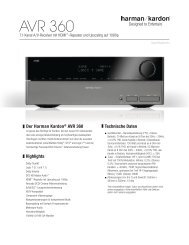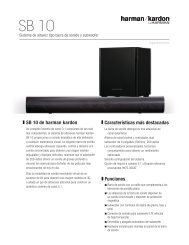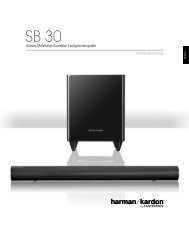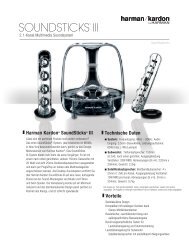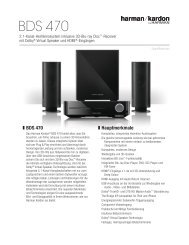Owner Manual - AVR 158 (English EU) - Harman Kardon
Owner Manual - AVR 158 (English EU) - Harman Kardon
Owner Manual - AVR 158 (English EU) - Harman Kardon
You also want an ePaper? Increase the reach of your titles
YUMPU automatically turns print PDFs into web optimized ePapers that Google loves.
<strong>AVR</strong> <strong>158</strong> Making Connections, continued<br />
HDMI devices<br />
If any of your source devices have hdMI connectors, using those connectors will provide<br />
the best possible video and audio performance quality. Since the hdMI cable carries<br />
both digital video and digital audio signals, you do not have to make any additional audio<br />
connections for devices you connect via hdMI cables, although you can assign one of<br />
the digital audio connectors to one of the hdMI inputs.<br />
14<br />
AVr<br />
hdMI connectors<br />
hdMI cable<br />
(not supplied)<br />
hdMI-equipped<br />
Source device<br />
to hdMI<br />
output<br />
Component video devices<br />
If your blu-ray disc or dVd player does not have an hdMI connector but does have a<br />
component video connector, using the component video connector will provide superior<br />
video performance. You will also need to make an audio connection from the player to<br />
the AVr.<br />
AVr dVd component<br />
Video connectors<br />
component Video<br />
cable (not supplied)<br />
to component<br />
Video outputs<br />
component Video-equipped<br />
blu-ray disc or dVd player<br />
Composite video devices<br />
You will need to make composite video connections from your source devices that do<br />
not have hdMI or component video connectors. You will also need to connect the source<br />
device’s analogue audio outputs to the AVr’s corresponding analogue audio connectors.<br />
IMPORTANT: If you connected your blu-ray disc or dVd player to the AVr’s dVd<br />
component Video Input connectors, do not connect a source device to the AVr’s dVd<br />
composite Video Input connector.<br />
AVr composite<br />
Video connectors<br />
composite Video<br />
cable (not supplied) to composite<br />
Video output<br />
composite Video-equipped<br />
Source device<br />
Optical digital audio devices<br />
If your source devices have optical digital outputs, connect them to the AVr’s optical<br />
digital Audio connectors. NOTE: Make only one type of digital connection (hdMI, optical<br />
or coaxial) from each device.<br />
AVr digital Audio<br />
connectors<br />
optical digital Audio<br />
cable (not supplied)<br />
to optical digital<br />
Audio output<br />
optical digital-equipped<br />
Source device<br />
Coaxial digital audio devices<br />
If your source devices have coaxial digital outputs, connect them to the AVr’s coaxial<br />
digital Audio connectors. NOTE: Make only one type of digital connection (hdMI, optical<br />
or coaxial) from each device.<br />
AVr digital Audio<br />
connectors<br />
coaxial digital Audio<br />
cable (not supplied)<br />
to coaxial<br />
digital output<br />
coaxial digital-equipped<br />
Source device<br />
Analogue audio devices<br />
Make analogue audio connections from your source devices that do not have hdMI or<br />
digital audio connectors. If you’re connecting video sources to the dVd, Video 1 or Video<br />
2 audio inputs, you must also connect the source device’s composite video output to the<br />
corresponding composite video connector.<br />
AVr Analogue<br />
Audio connectors<br />
Stereo Audio cable<br />
(not supplied)<br />
Analogue Source device<br />
to Stereo Analogue<br />
Audio output



